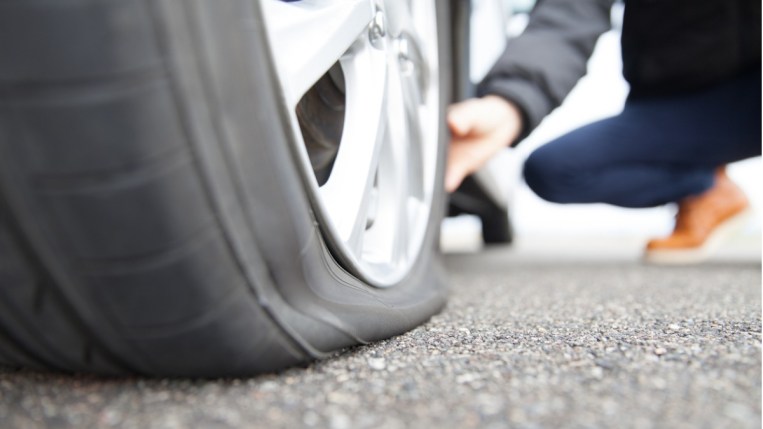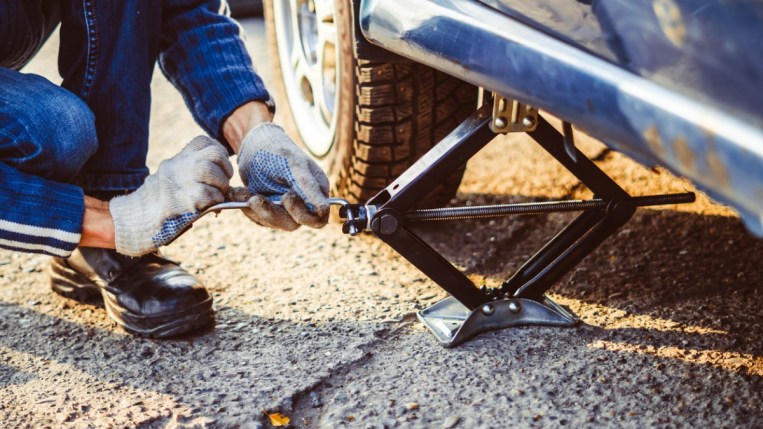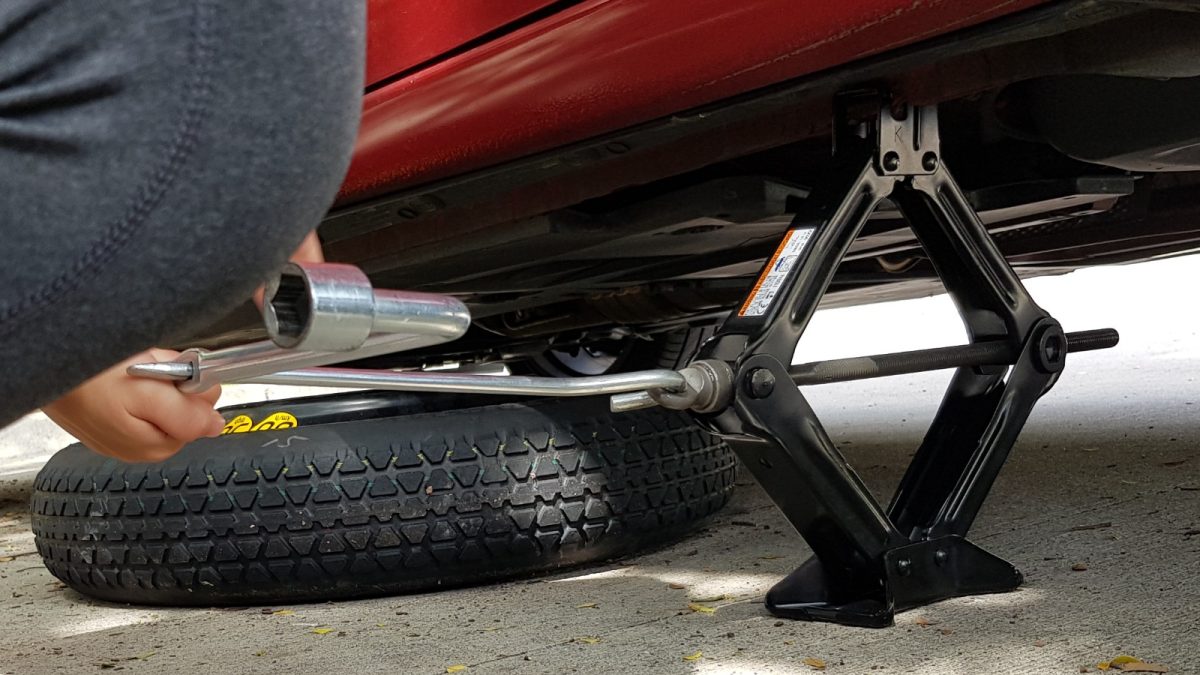Quick Tips About Changing a Tire
- You will need a jack, lug wrench, and spare tire to change a flat.
- Changing a flat tire only takes a few steps and can be done in minutes.
- Always change a tire in a safe, level area away from traffic.
Nobody wants to pull to the side of a busy road and change a tire, but knowing how to do so is essential if you get a flat and can no longer drive safely. While roadside services can be handy in some situations, drivers should be prepared to change a flat to get back on the road without being stranded waiting for help.
Keep reading to learn the steps for changing a flat tire quickly and safely.
Required Equipment to Change a Tire
You can’t predict when you will need to change a tire, so it’s good to be sure you have everything you need at all times. The task requires a couple of tools that are probably in your vehicle already. You will need a lug wrench for loosening and tightening the bolts that secure the wheel, and a jack for lifting the car. In most cars, these items are stored in the car’s trunk. If they are misplaced, you can purchase a lug wrench for around $20. A basic car scissor jack costs about $50. Some jack kits have cranks that double as wrenches.
Be sure to refer to the owner’s manual to know the points for setting the jack. Improperly jacking a car can damage parts under the vehicle and may not be covered by your insurance.
The most important thing you need is a replacement spare tire, typically found under the carpeting in the trunk or cargo area. Larger SUVs and trucks with full-size spares may have an external storage bracket under the rear of the vehicle.
Tip: Get into the habit of checking your spare tire’s air pressure monthly, as they lose air over time. You can buy a new spare at a local tire store or auto repair shop if the tire is missing or damaged.
Not all cars come with a spare tire, so it is essential to check your vehicle to make sure you know if you have one and where it is. Instead of a spare, some models have an emergency tire repair kit or sealant in the trunk or cargo area. The sealant material allows you to patch your flat tire long enough to get to a tire shop. But this is a last-resort option, as the sealant can make the tire irreparable.
If there is no sealant, your car might have run-flat tires. These special tires can be driven on for about 50 miles after a puncture, which may be enough distance to get you to a tire shop.
What to Do When You Have a Flat Tire

If you think you have a flat tire, safely pull off the road as soon as possible.
- Gently apply your brakes and move to the shoulder, onto a side street, or into a nearby parking lot.
- Never slam your brakes or make a sudden turn to get off the road because you could lose control of the vehicle with a damaged tire.
- Ensure you have enough space in a level area to change the tire to minimize the risk of being hit by approaching traffic.
Always be aware of your surroundings and be mindful of your personal safety.
Steps to Change a Tire

Follow these 10 steps to change a tire after finding a safe place to stop away from traffic.
- Stop safely. Park away from traffic on level, solid ground. Engage the parking brake to reduce the chances of your car rolling away. Turn on your hazard lights to make yourself more visible to other drivers.
- Locate tools and supplies. Get out the lug wrench, jack, and spare tire typically found in the truck. Place wheel wedges or a heavy object behind the wheels to help keep the car steady. Some drivers keep a portable inflator, pressure gauge, and a toolkit that includes a flat-head screwdriver stored in the car.
- Loosen lug nuts. Using the lug wrench, loosen the lug nuts for the wheel you’re replacing just enough so that they can be unscrewed with your hand. Some cars have a hubcap covering the lug nuts. If necessary, remove the hubcap to expose the lug nuts.
- Raise vehicle. Place the jack beneath the exposed metal under the vehicle at the jack point near the flat tire and use it to raise the car slowly. If you do not see the notch on the frame indicating the jack point, refer to the owner’s manual for the exact spot to set the jack. Lifting the vehicle in the wrong location could cause damage or injury.
- Remove lug nuts and flat tire. Once you’ve lifted the car high enough for the wheel to be off the ground, finish unscrewing the lug nuts and place them where they will not be lost. Now remove the tire from the vehicle. Place it flat down so it won’t roll away. In rare cases, the wheel may rust to the wheel hub. If it is stuck, lower the jack slightly so that just a little of the car’s weight settles onto the wheel with the lug nuts removed, breaking any seal. Then raise again to remove the wheel.
- Install spare tire and replace lug nuts. Place the spare tire onto the vehicle by lining up the holes with the threaded bolts called wheel studs. Replace the lug nuts and hand-tighten each one. Do not tighten them completely.
- Lower vehicle. Using the jack, slowly lower the vehicle so the spare tire lightly touches the ground so the wheel doesn’t spin. Do not put the car’s total weight onto the tires yet.
- Tighten lug nuts. Use the lug wrench to tighten all of the lug nuts. Tighten them in a crisscross or star pattern, not one by one in a circle. Repeat the pattern to ensure each nut is tight.
- Remove jack. Completely lower the vehicle after tightening all the lug nuts. Remove the jack.
- Store tools and flat tire. Replace the jack, lug wrench, and flat tire in the car. Drive directly to a gas station to inflate the spare to an adequate air pressure if a portable air compressor is not available.
Remember that a spare tire is not a permanent tire. Do not drive far with it. Once you replace the flat with the temporary spare, go to your local tire shop and have the original tire replaced or repaired.
Changing an EV Tire

Electric vehicles (EVs) do not use the same tires as gas-powered cars of similar size. The heavy battery pack in the EV adds weight that a standard tire cannot withstand, leading to premature wear and tear. So, EVs use specialized tires to handle the extra weight and the torque that come with the instant power from the electric motor.
In theory, changing the tire of an electric car is identical to the process for a gasoline-powered car. However, most EVs do not come with spare tires in order to provide more space for the battery pack and limit excess weight. Plus, many newer EVs have run-flat tires that eliminate the need for a temporary spare.
Not all EVs lack a spare tire. For example, the Ford F-150 Lightning and the GMC Hummer EV are equipped with spares.
When to Replace a Tire
Tires are a critical safety component of your car, but a puncture can happen any day and never at a convenient time. You might drive over a nail on your daily commute or dive into a pothole on your way to the store. The car suddenly shaking or pulling to one side may indicate a deflated tire. Safely pull out of traffic to check the tire for damage or objects stuck in it.
Sometimes you can see an object, such as a nail in the tire, but the tire isn’t deflated. Leave it in the rubber and go to a tire shop. However, if you pull over and see the tire looks flat, you will need to replace it with the spare.
Do not attempt to drive on a flat tire, even if a local tire shop is nearby. Driving with a flat is dangerous, it may ruin the tire, and it can damage the rim.
Editor’s Note: This article has been updated since its initial publication.








